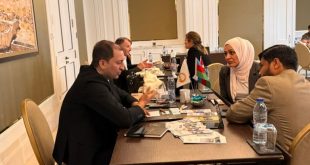Human development is an “evolutionary process” whereas destruction is always “short-spanned”. There is no comparison between “generosity” and “genocide”. There is no match between “economic sustainability” and “ethnic cleansing”. That is why Azerbaijan always stood for higher “human values” whereas Armenia remained “schemer” of “horrendous crimes” against humanity for the last so many centuries.
However, the famous 44 days “Patriotic War” changed the landscape of South Caucasus and “sacred blood” of unlimited “martyrs” liberated more than”8,000 square kilometers” of territory in and around Karabakh. Aggressor (Armenia) was badly defeated and real owners of the land (Azerbaijan) regained their lost “paradise”.
Now diversified, balanced, innovative, smart and befitting socio-economic development is at its peak in all the newly liberated areas of Karabakh. Diversified but integrated development, beautification and resettlement activities are being carried out in all the new regions which would definitely further enhance Azerbaijan’s economic strength and potential in the days to come.
It seems that under the visionary leadership of President Ilham Aliyev Azerbaijan is “transforming” Karabakh into a platform for development, peace and security which has huge economic potential. Azerbaijan is worldwide famous for its models of “tolerance” and “multiculturalism” has also announced plans to rebuild the Christian and Muslim heritage of Karabakh, following the devastation of the patriotic war of 44 days and the neglect that the region had experienced under illegal occupation of Armenia.
In this connection, most recently, President Ilham Aliyev and his counterpart, President Recep Tayyip Erdogan inaugurated the Fuzuli International Airport in Azerbaijan’s recently liberated city in the region of Karabakh.
It is completed in eight months. It is the first airport in the newly liberated areas. President Recep Tayyip Erdogan became the first head of state to land at Fuzuli International Airport. The International Air Transport Association (IATA) has included it on the list of international airports with the code of FZL. Thus, the airport will serve as Karabakh’s gateway to the world.
It is hoped that this airport will contribute to the development of tourism and trade in the region. Travelers going to Shusha, the symbolic city of Karabakh, will also be transported via this airport. The airport is approximately 100 kilo-meters (62 miles) from Shusha and 300kilometers from the capital Baku. Moreover, all wide-body aircraft, including large cargo airplanes, will be able to operate from this airport.
The airport’s runway is 3000m long and 60m wide and its terminal has the capacity to handle 200 passengers in an hour. In addition, it features automatic systems and a control tower in line with international civil aviation and transportation standards.
The aviation infrastructure has baggage conveyors, VIP lounges, a registration system, shops, restaurants and other necessary facilities.
On the other hand, Azerbaijan’s President Ilham Aliyev has already declared Shusha the “Cultural Capital” of Azerbaijan. Historically, Shusha has been one of the important centers of historical, cultural, socio-political life of Azerbaijan for centuries.
President Ilham Aliyev decided to restore the historical appearance of Shusha, up to its former glory and reunite it with a rich cultural life, as well as promote Azerbaijan’s rich culture, architecture and urban planning in the international arena.
It was “massacred” and illegally “captured” by Armenia on May 8, 1992. During all these “painful” years, it has been “symbol” of “human resistance”, “purity”, “dignity”, “cultural diversity” and “peaceful struggle”. Ultimately, the “Pearl of Karabakh” Shusha was liberated on November 8, 2020.
It is known as a “symbol” of Azerbaijani history and culture. Many prominent Azerbaijani musicians and scholars were born in the city.
Azerbaijan has established the “Special Representatives Institution of the President” in Shusha, a cradle of Azerbaijani culture. The other newly established unit, the Karabakh Revival Fund, will provide financial support for restoration and reconstruction in the Azerbaijani territories.
It has 17 neighbourhoods namely, Seyidli, Julfalar, Guyulug, Chukhur neighbourhood, Dord Chinar, Dordlargurdu, Haji Yusifli, Cholgala, Gurdlar, Saatli, Kocharli, Mamayi, Khoja Marjanli, Damirchilar, Hamamgabaghi, Merdinli and Taza mahalla. They belonged to the Azerbaijan people who built it.
In addition to the natural fortress, the city itself was surrounded by magnificent castle walls. The entrance to exit from the city was through the gates of Ganja, Aghoghlan and Yerevan.
In addition to this, Zangazur Economic Corridor (ZEC) is the economic “life-line” of many regional countries of South Caucasus and beyond. It is an ideal regional “connecting hub” of economies, trade & commerce activities, transport systems, blue economies and above all greater regional connectivity. Thus rigorous development work is being considered to build this important economic corridor as soon as possible.
It is hoped that construction of the ZEC will increase regional economic along with that of the countries of the South Caucasus, serves the interests of all stakeholders interested in the development of the North-South and East-West corridors.
Especially, the European Silk Road, China’s Belt and Road Initiative (BRI), Turkey’s Middle Corridor project and Azerbaijan’s transport and logistics capabilities will serve to complement each other in the Nakchivan corridor, according to an inked agreement between Armenia and Azerbaijan in 2020.
Moreover, the Zangazur corridor will end the isolation of the Nakchivan Autonomous Republic, Azerbaijan’s landlocked exclave, and will at the same time, embolden Eurasian connectivity.
In this connection, right after the peace agreement between Azerbaijan and Armenia, on November 2020 all kinds of work on the decontamination, reconstruction, rehabilitation and reintegration of liberated Karabakh had been initiated.
The resettlement of real owners of the newly liberated regions through sustainable settlement while reintegrating economic activity, is one of Azerbaijan’s five national priorities outlined in the country’s “2030 Strategy,” which has been based on the United Nations’ “Transforming our World: The 2030 Agenda for Sustainable Development.”
In this regard, Azerbaijan is now determined to mobilize/utilize all financial resources and stakeholders to revitalize Karabakh, to transform “ghost settlements” into smart cities and smart villages, with a particular focus on the needs of the most vulnerable groups the1 million internally displaced persons (IDPs) and refugees.
The foundation of the first smart village has already been laid in the Zangilan district. It is centered on five components: housing, manufacturing, social services, “smart agriculture” and renewables.
The idea of smart cities/villages has become popular around the world. It envisions small communities using the latest technologies like digital connectivity, automation, and renewable energy to maximize economic development.
In this context, a State Program of Socio-Economic Development of Regions of the Republic of Azerbaijan 2019-2023 called for two pilot “smart villages” in the near future.
In February, President Ilham Aliyev said that the first smart village project would be implemented in Uchunju Aghali, in the Zangilan district.
Hopefully, the smart villages will introduce agriculture based on “modern technologies and joint management and control. “The concept consists of ‘smart’ street lighting, cold-and heat-resistant homes, management of household waste, the installation of hydro and solar power stations and biogas energy.
Azerbaijan’s pursued a Model of Circular Economy (MCE) in Karabakh which is now addressing several of the “Sustainable Development Goals,” such as sustainable cities and communities, responsible consumption and production and climate action.
A newly created institution, Azerbaijan’s Mine Action Agency (ANAMA), has started work despite having no maps of the mined areas, as the Armenian side has failed to provide them.
Moreover, Azerbaijan is committed to develop green energy in Karabakh. A quarter of Azerbaijan’s domestic water resources, which amounts to about 2.56 billion cubic meters (bcm) of water a year, originates in Karabakh.
The main rivers of the region, the Tartar, Bazarchay (Bargushadchay), Hakari and other, smaller rivers have great potential for hydropower.
Karabakh’s solar energy potential is estimated at 3,000-4,000 megawatts and its wind energy potential at 300-500 megawatts.
Hopefully, the Khudafarin and Maiden Tower hydroelectric power stations, will generate 280 MW energy, whereas the planned hydroelectric power plants in the Kalbajar-Lachin area will provide 120 MW of energy, allowing the region to rely on green sources, as these fully meet the region’s primary energy needs.
In addition, the thermal water resources of 3093 m3/day in the Kalbajar region and 412 m3/day in Shusha have further increased potential for the development of green energy.
The government’s emphasis on increased environmental protection in Karabakh, is the country’s most compelling response to the challenges of global climate change.
Unfortunately, the total forest area was reduced to 174,000 hectares as the result of mass deforestation during the illegal Armenian occupation, although total forest reserves accounted for 228,000 hectares before the occupation.
Azerbaijan has already launched a massive reforestation drive in Karabakh forested areas, which includes the Basitchay and Garagol state reserves, as well as the Lachin, Gubadli, Arazboyu and Dashalti state nature preserves.
Hopefully it will provide an invaluable contribution to the country’s efforts to reduce climate change, desertification and deterioration of biodiversity and disruption of the balance of gases in the atmosphere, while also contributing to the socio-economic development of Karabakh.
In 2021, a public investment of $1.3billion (TL 10.61 billion) in Karabakh was announced. It will be used for the construction of new roads, electricity, gas and other infrastructure facilities which will consequently foster growth in the economy, as well as potential grow thin the future.
Fortunately, Karabakh has outstanding development potential in mining, metallurgy, the creative industries, the food industry, knitwear, tourism, agriculture and green energy. In this connection the government of Pakistan, armed force of Pakistan and its private sector has already shown keen interest to make investments in the newly liberated areas of Karabakh.
The government of Azerbaijan is perusing the “Solow Model (SM),” for the development of Karabakh which will generate more value addition similar to Germany and Japan, countries that managed to build a competitive economy on the ruins of World War II.
To conclude, since the time immortal, development has been judged as one of the most important actors of human survival, economic progress and political stability. Since biblical prophecies especially Moses, Jacob, and Joseph and modern day military “misadventures” compelling of genocides, ethnic cleansings, and discriminations could not achieve anything but just “self illusion”, “short lived” self inserted/imagined “glory” and “gratification” which mere created “euphoria” of “cognitive dissonance” and fascist Armenia is its prime example.
However, peaceful persuasions of human survival, progress, prosperity, dignity, protection of territorial sovereignty has been “part and parcel” of Azerbaijan, the first “Democratic Country” of the whole Muslim World which also granted rights of vote to “Women” even before so many civilized countries of the world.
Ours is the age of economic liberalization, socioeconomic integration, greater regional connectivity and liberalized democracy. In this regard, immense socioeconomic development of newly liberated areas Karabakh would be “stimulator” to all regional countries and their economies too. It would be “launching pad” for further strengthening of bilateral and trilateral benefiting socio-economic partnerships and geopolitical strategic ties. In this connection, Azerbaijan, Pakistan and Turkey have already embarked towards this end goal of Trilateral Strategic Dialogue (TSD) which would provide win-win proposition to all the countries.
RIAZ AHMED MALIK
GROUP EDITOR
Daily National Herald Tribune
and Daily Al-akhbar
RIAZ AHMED MALIK
GROUP EDITOR
Daily National Herald Tribune
and Daily Al-akhbar
RIAZ AHMED MALIK
GROUP EDITOR
Daily National Herald Tribune
and Daily Al-akhbar
RIAZ AHMED MALIK
GROUP EDITOR
Daily National Herald Tribune
and Daily Al-akhbar
GROUP EDITOR
Daily National Herald Tribune
and Daily Al-akhbar
Daily National Herald Tribune and Daily Al-akhbar Group Editor Riaz Ahmed Malik and Director, Geopolitics/Economics Member Board of Experts, CGSS, Dr. Mehmood Ul Hassan Khan
 Oval Useful news from Azerbaijan and Caucasus
Oval Useful news from Azerbaijan and Caucasus


